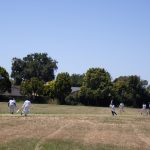Editor’s note: This story was produced for the independent Mosaic Journalism Program for Bay Area high school students, an intensive course in journalism. Students in the program report and photograph stories under the guidance of professional journalists.
Despite the Latino population making up a quarter of the Bay Area, local Latino journalists have been fighting a lack of representation of their culture in the news industry for decades.
In a 2022 study by the Pew Research Center, 76% of journalists surveyed were white compared to the 8% who were Hispanic or Latino. A study by the Government Accountability Office in 2022 showed that from 2010 to 2019, the percentage of Latino workers in all media, not just news, had only increased by 1 point.
But the struggle was felt long before these figures surfaced. Juan Gonzales said he founded El Tecolote in 1970, the first Spanish-language newspaper in San Francisco, because he felt that the city’s daily newspapers weren’t accurately representing Latinos.
“You only ever see gangs and shootings instead of reports asking for better social work and actual morals,” Gonzales said.
He added that news directors and reporters have focused too much on white people to hire and use as sources, limiting Latino representation and leaving the community more vulnerable to stereotypes.
Gonzales said he was also inspired to start El Tecolote to improve the diversity of news coverage. He recounts attending a strike where someone told him that they could use more diverse coverage from someone like him in the Mission District.
Related Articles
East Palo Alto program feeds region’s hungry residents
San Jose’s textiles museum nears fundraising goal
San Jose performance connects teens to legends of their parents
Google’s huge San Jose project moving ahead
New San Jose cafe combines coffee and kitties waiting for adoption
Alberto Mendoza, a former executive director of the National Association of Hispanic Journalists, shared those ideas.
“The more Latino murderers and criminals are given screen time, the more damage is done,” Mendoza said.
Mendoza said he was inspired to apply to NAHJ in 2021 after seeing Donald Trump’s statements about Mexico sending their worst people to the United States, and wanted to champion more accurate and better news coverage of Latinos.
He added that the mission is an ongoing fight, pointing to recent layoffs in the news and tech sectors. When the Los Angeles Times laid off 20% of its newsroom in January, a large number were Latino, which he said will hurt efforts to produce faithful portrayals of Latinos in the country.
But the main issue throughout history isn’t just a Latino problem, said Catalina Lopez, a 17-year-old Santa Clara High School newspaper editor. She believes that uninformed stereotypes and misrepresentation in news extends to people of color in general.
“Journalism is a broad thing, there’s so many things one can say, but there’s not enough voices. On the news like CNN and Fox, they’re all white. Maybe there’s one African American, but it’s mostly white. It’s misleading for themselves and the program,” Catalina said.
Mendoza urged multicultural collaboration, like when NAHJ has worked with the National Association of Black Journalists and the Association of LGBTQ+ Journalists.
“We’re stronger together and the challenges are the same. Diverse pools learn from each other and share their experiences,” Mendoza said.
Gonzales encourages Latinos to put pressure on news media to portray them accurately. Otherwise, he said, Latinos will avoid reading the news because they don’t see themselves in it.
But he is confident in the community’s power to inspire change.
“Damn it, we’re conscious about what we have to do and how to do it,” he said.
Jorge Ramirez Gomez is a member of the class of 2025 at San Jose High School.


